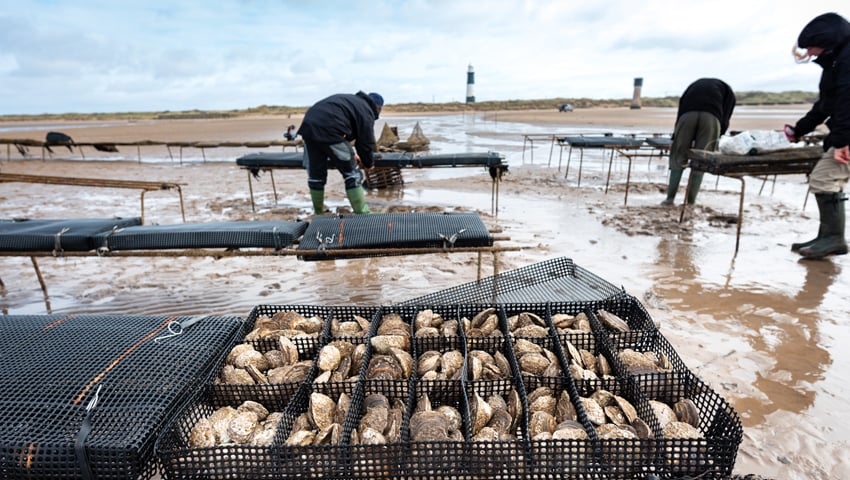The pioneering restoration project, Wilder Humber – in partnership by Yorkshire Wildlife Trust, Lincolnshire Wildlife Trust and Ørsted – is breaking new ground by trialling remote setting, an innovative restoration method never before used to restore native European flat oysters in the UK.
The Humber estuary was once home to a thriving population of European flat oysters. Past records indicate one such oyster reef was estimated to cover over 300 acres of the foreshore, meaning large amounts of oysters could be seen at low tide from the seafront.
However, historical overfishing, poor water quality and disease decimated these once-abundant reefs. Today, the once-mighty native oyster populations along UK coasts are fragmented and depleted, too isolated to naturally recover.
The restoration and preservation of oyster reefs are vital for maintaining healthy, resilient marine and estuarine ecosystems. Oyster reefs play a crucial role in supporting the marine environment, offering a range of significant benefits.
The oysters themselves act as powerful water filters, helping to maintain cleaner seas by improving water clarity and reducing excess nutrients.
Additionally, as oyster reefs establish, they create essential nursery habitats, providing shelter and breeding grounds for a wide variety of marine species. Beyond their support for wildlife, oysters reefs benefit coastal communities by serving as living breakwaters, reducing wave energy, stabilising sediments and helping to protect coastlines from erosion.
Launched in spring 2023, Wilder Humber is working with The Nature Conservancy and The Oyster Restoration Company to reintroduce 500,000 oysters into the Humber estuary over 5 years, an important step towards revitalising the Humber’s native oyster population.
Remote setting
Typically, native oyster restoration involves purchasing juvenile and adult oysters to be placed directly onto the seabed. However, this method can cause transportation stress on the oysters, incurs high costs, impact the donor stocks and often results in low survival rates. The initiative marks the first trial of using remote setting to reintroduce native oysters in the UK, paving the way for innovative restoration practices.
Dr. Nik Sachlikidis, CEO of The Oyster Restoration Company, said, “The Oyster Restoration Company is excited to join forces with Yorkshire Wildlife Trust and The Nature Conservancy in this groundbreaking project, the first of its kind in the UK.
“By collaborating with knowledgeable and mission-aligned partners, we are taking a major step towards scalable onshore and offshore deployment that will significantly enhance biodiversity. The positive impact of native oysters on marine ecology is profound, and together, we are paving the way for further native oyster restoration projects, ensuring a healthier and more resilient environment for the future.”
The collaboration will see adult oysters spawned at The Oyster Restoration Company hatchery in north-west Scotland where they produce millions of tiny larvae. The larvae will be carefully transported to Spurn Point National Nature Reserve, where they will be introduced into a tank filled with scallop shells. There, they will settle on the shells over 3 days and become permanently attached. The shells and attached larvae will then be held in the oyster nursery at Spurn Point where the restoration team will monitor their growth and development until they are ready for releasing into the Humber estuary.
Laura Welton, Native Oyster Restoration Officer at Yorkshire Wildlife Trust, said, “Remote setting is beneficial because it allows the seeded oysters to be produced closer to where they will eventually grow, improving acclimatisation, reducing transportation stress, improving the chances of successful oyster cultivation, and reducing costs.
“We hope to see a high number of oyster larvae settled on the scallop shells. If the trial is successful, this method has substantial potential for creating larger native oysters reefs in the Humber and around the UK.”
Boze Hancock, The Nature Conservancy, said, “While remote setting is only one tool to help the restoration of a critical habitat in the North Sea and surrounding waters, it has proved to be powerful in enabling restoration at scale.
“From the US to Hong Kong and Australia it is a tool that has really helped restore oyster reefs and it will help the work in the Humber estuary. Beyond the Humber, the technique will be essential for integrating oyster restoration into the construction of offshore wind in the North Sea. So this demonstration is an important step in our ability to restore the function of our marine ecosystem regionally.”
Samir Whitaker, Biodiversity Lead Specialist at Ørsted, said, “We are excited to be part of Wilder Humber, through which we are taking action to tackle two urgent challenges that are too often addressed separately: halting and reversing biodiversity loss and preventing catastrophic climate change.
“Restoring our lost marine ecosystems, at scale, is one of the best approaches we have to storing carbon as well as providing vital habitat such as oyster reefs which support numerous other species.
The remote setting trial is a significant step forward in the ambitious Wilder Humber project, which seeks to revive the region’s biodiversity and safeguard its delicate ecosystems.
Wilder Humber is delivered through a pioneering conservation partnership between Yorkshire Wildlife Trust, Lincolnshire Wildlife Trust, and Ørsted. It uses a seascape-scale model, combining sand dune, saltmarsh, seagrass, and native oyster restoration to maximise conservation and biodiversity benefits.
Image: Finn Varney
